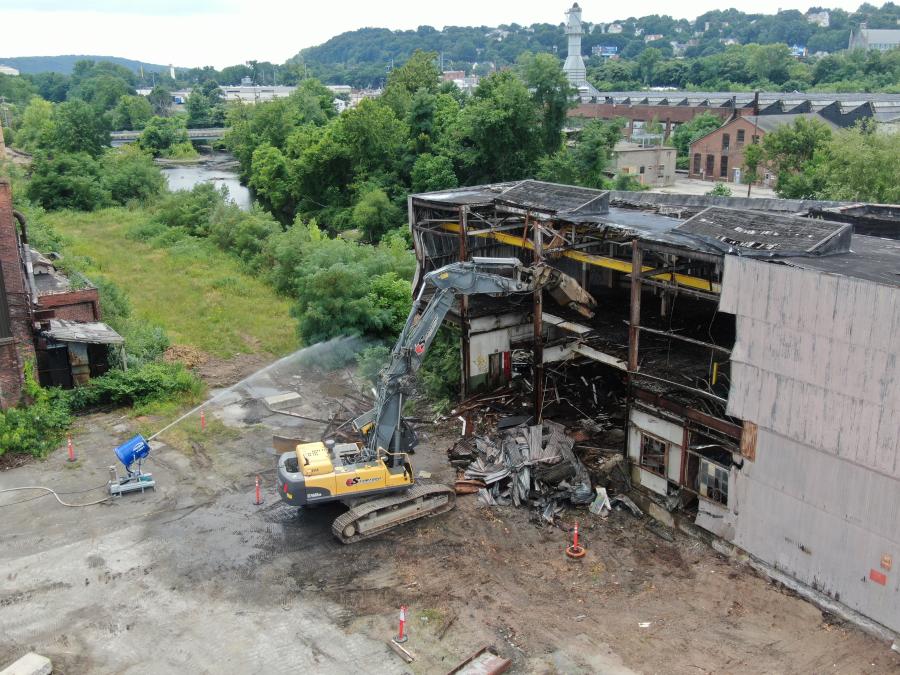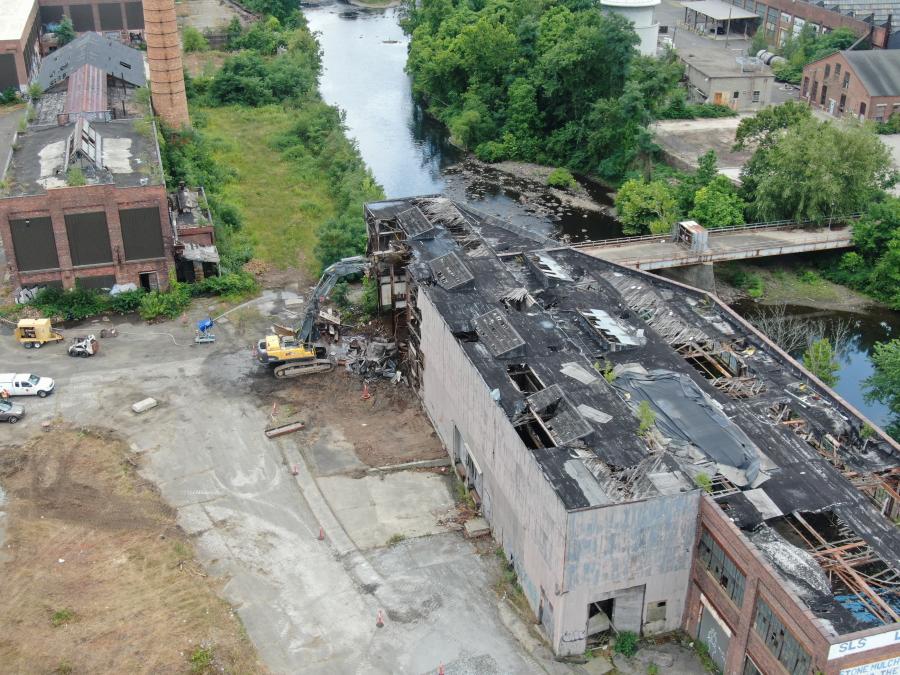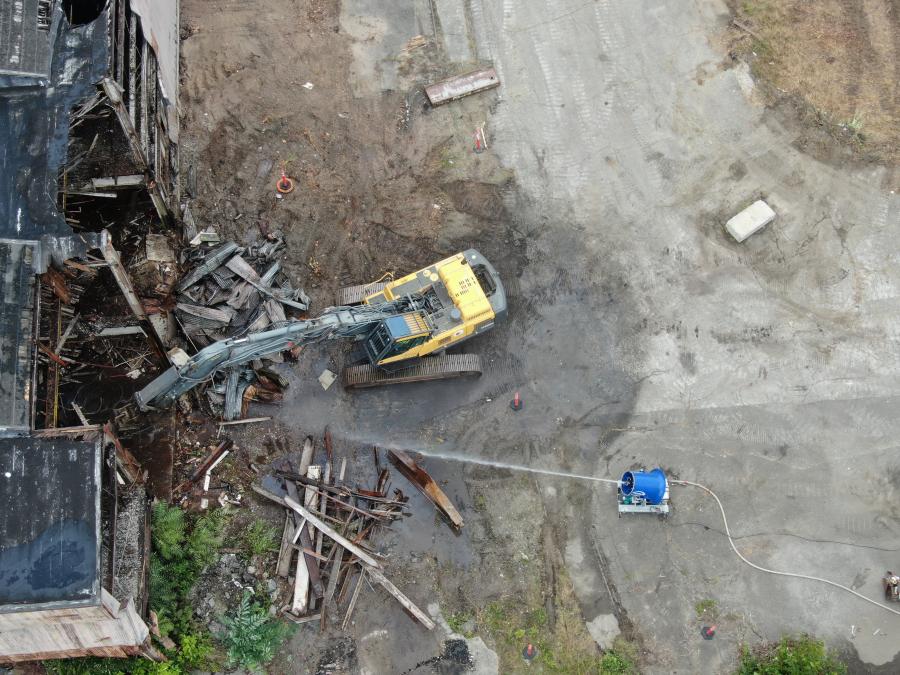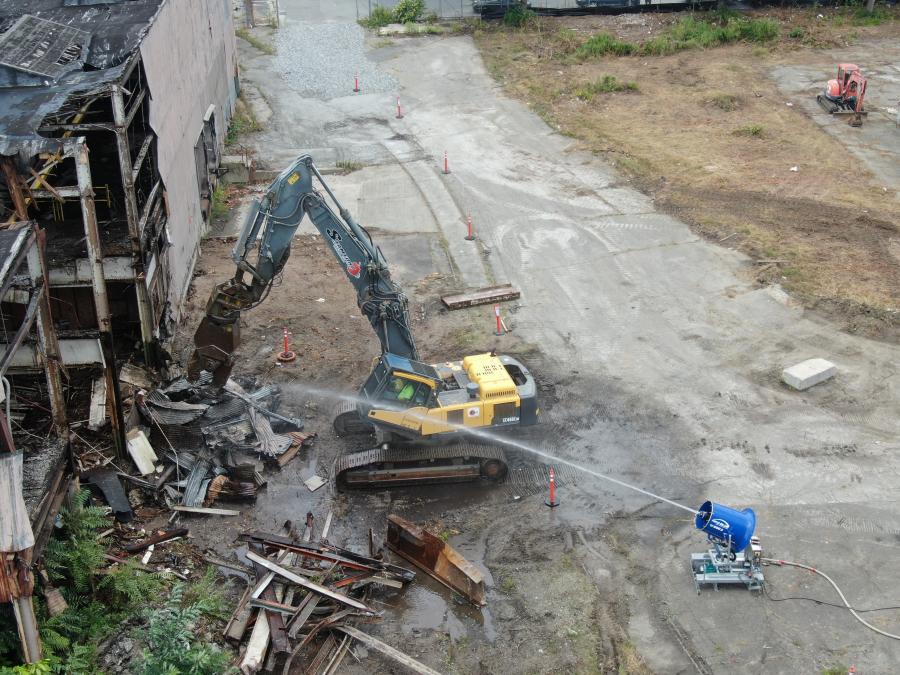The Waterbury Development Corporation has hired Stamford Wrecking Company to complete the second phase of the demolition of the former Anamet site located at 698 South Main St.
(Photo courtesy of Stamford Wrecking Company)
The city of Waterbury, Conn., once known as America's "Brass City" due to the many brass manufacturing plants located within it, is now, via its Waterbury Development Corporation (WDC), demolishing many of the factories and taking steps to clean up the contaminated sites to allow for future development.
The WDC has hired Stamford Wrecking Company to complete the second phase of the demolition of the former Anamet site located at 698 South Main Street, which is currently owned by 698 South Main Street Inc., a single-purpose entity created to redevelop the property.
The site was used for manufacturing purposes from 1812 to 1977 by Benedict & Burnham Manufacturing Company, American Brass, Anaconda American Brass and ARCO. The majority of the site is currently vacant.
To cover the cost of the demolition and clean up, the city was recently awarded $2 million in USRAP funding, as authorized by the State Bond Commission, to use toward Phase II of the Anamet project. It also was awarded $2 million in DECD Brownfield Municipal Grant Program funding and $200,000 in NVCOG EPA RLF funding to use at the site.
"Both funding sources will further demolition, remediation and eventual redevelopment on the site," according to the WDC.
"The 1-acre site sits just outside downtown Waterbury with close proximity to highway, rails and phase 2 of the Waterbury greenway project," said Thomas Hyde, the WDC's interim director. "[The 698 company] was created in 2017 to acquire the site and has been working to remediate and redevelop it."
Phase 1 demolition was completed by Manafort Brothers and six buildings were demolished.
"The site was recently advertised for redevelopment," said Hyde. "Decisions on the end user will be made in the coming months."
For the second phase, which began in early August, Stamford is demolishing three large buildings. The project should wrap up the end of the year.
The first building, which is 80 percent demolished, is Building 33/33A, a 16,000-sq.-ft. single story high-bay storage structure that is 25 ft. tall.
"The demolition is being performed under a State of Connecticut Department of Health Alternative Work Practice [AWP] due to the poor condition of the structure," said Bryan Terlizzi, Stamford's senior project manager. "At this time, the building is down and we are working on cleaning up all the debris and should be done within 1.5 to two weeks. For all the buildings that we are demolishing, we're only doing the above grade portions. All of the concrete foundations are staying in place."
The second structure (15,000 sq. ft.), referred to as Building 27/27A/27B, is based on three interconnected high-bay sections that are two stories and 40 ft. tall.
"This is the former powerhouse that housed all the boilers and mechanical equipment that ran all the various former buildings on the site," said Terlizzi. "It is also in poor structural condition and will be demolished under an AWP process. We started the demolition on August 18, and we expect it to be ongoing for the next four to five weeks."
The third building, located along South Main Street, is an 11,000-sq.-ft., four-story former office building.
"We're going to perform a traditional asbestos abatement prior to demolition, where we'll remove all the contaminated materials," said Terlizzi. "Once it is cleared by the environmental company, we will do the demolition in a standard manner where the materials are going off site as clean demolition debris."
All the utilities were disconnected for the first phase and there are no active utilities beneath the site.
Building 33/33A has had its share of difficulties.
"It was a challenge because it was constructed along the Naugatuck River and we had to implement what is called a turbidity barrier, a device that is installed in the river so that in the event any debris falls into the river, it doesn't float away," said Terlizzi. "The curtain keeps the debris along the shoreline. The building is down. Due to its location by the river, we had to start from the north end, which was not along the river, and work down to the section that was by the water. Everything was methodical — we just pulled everything in toward the slab so that no materials ended up in the river and we did that successfully.
"The second building has a couple of challenges, one being that there are various basement and tunnels underneath the slab, which is not strong enough to hold up our heavy equipment that we are using," he added. "We've overcome that by using our Volvo 460 high reach excavator, which has 92 feet of reach and allows us to perform the demolition outside the building footprint. The other challenge that we are going to be faced with is the approximately160-foot-tall smokestack, which is in poor condition — there is severe cracking through all the bricks. Once the building is down, we are going to approach that structure. We will remove the first 100 feet or so with a man in a bucket lifted by a crane and once we get it down to a reasonable height, we can manage it with excavators to bring it down to the sub elevation."
Bringing down the office building won't be easy as it is directly adjacent to the sidewalk along South Main Street.
"When we get to the front of the building, we're going to implement certain traffic control patterns to make sure no pedestrians or cars are endangered by our work," said Terlizzi. "We are going to use the Volvo high reach excavator to reach up to mechanically demolish the face of the building so that we can control all of the debris so that nothing gets outside of the controlled work area along the street."
To ensure that no asbestos flakes and other contaminated and non-contaminated debris is blown away by the wind, water is being sprayed via a HDK water misting machine that has a range of up to 300 ft. to shoot mist and water.
"It is run throughout the day and is basically placed along the site based on the wind conditions," said Terlizzi. "We are moving it from place-to-place and we are keeping the material wet. We have captured dust particulates that may become airborne."
Equipment-wise, crews are using the Volvo 460 high reach excavator, a 165,000-lb. Volvo 700 excavator, Bobcat 220 skid steers, a Caterpillar 973 track loader and several Cat 320 excavators.
Planning is essential for dealing with dilapidated buildings that contain contaminated materials.
"It is especially so when you have the environmental challenges that we have with these buildings that have failed structurally," said Terlizzi.
The safety and health of the workers and the public also is paramount for Stamford. All the crew members have been trained and licensed to work with hazardous materials, and they are wearing half-faced respirators and coveralls when inside the regulated work area.
"We have them go through a shower system when they leave the work site," said Terlizzi. "They take off the coveralls that may have come in contact with asbestos contaminated materials. Waterbury hired an environmental consultant that does perimeter air monitoring around the work area throughout the day to confirm that there are no emissions of asbestos particulates that leave the work area. They are testing air samples to make sure we are in compliance with the state regulations. Safety is paramount; it is the number-one concern. We want to make sure our guys show up to work every day and get home safely to see their families every night."
Currently there are 12 Stamford personnel on site, which will increase when the asbestos abatement crews arrive.
Terlizzi is supported by Superintendent Wallace Hitchcock.
"Wally has been with the company for over 25 years, and I've been here for 13 years," said Terlizzi. "We have been working on projects ever since I joined the company. He is one of our most experienced superintendents and has a long track record of handling these large-scale environmental demolition projects from start to finish with successful completions — on time and under budget. Stamford wrecking has been in business for almost 100 years and most of our operating engineers have been with the company for more than 20 years. The operators that we have working on this site are specific to this type of work because of their asbestos contaminated materials training and are all experienced in dealing with different demolition projects."
Terlizzi anticipates crews will handle more than 6,000 tons of materials.
"About 50 to 60 percent of the debris is going to be handled as asbestos containing and it is going to a landfill in New Hampshire that is permitted to receive this material," he said. "The remainder is going to be handled and dispersed as non-contaminated material."
The contaminated material is being transported to New Hampshire by truck.
So far, no major equipment issues have arisen.
"This isn't going to create any novel wear and tear on the equipment," said Terlizzi. "All of our excavators have various attachments, whether they be grapples, concrete processors, hydraulic hammers or standard buckets. We're equipped with attachments to handle different types of materials. If we're dealing with a lot of steel, we'll put the shears on and if we're dealing with concrete and brick, we'll put the processors to bring everything down to manageable pieces to dispose of.
"It's standard maintenance so far and most of it is done either before the start of the day or at the end of the shift," he added. "It has not resulted in any down time during the day. The typical greasing and maintenance are done during off-hours. Our senior mechanic for the company oversees the maintenance and repairs of the equipment on site."
Stamford purchases and rents equipment from dealerships such as H.O. Penn Machinery in Newington, Conn., and Tyler Equipment Corporation in Berlin, Conn.
"It's really about handling maintenance internally," said Terlizzi. "We have our mechanics at our yard and in the field. We just source the parts we need from the dealerships.
"The interesting thing about demolition is that every building is different," he added. "When you have a lot of experience and understanding of being prepared, you know what to do. But since every project is different, we put in a good amount of time in the planning phase to evaluate the building and understand how it was structurally constructed, which allows us to come up with the game plan to demolish a structure."
Stamford has done a lot of work for Waterbury.
"We always praise them [Waterbury] for their forward thinking and efforts to clear up a lot of these old, worn-down manufacturing sites," said Terlizzi. "They do a great job to get these buildings rehabilitated or removed to keep the image of the city as good as it can be." CEG
Irwin Rapoport
A journalist who started his career at a weekly community newspaper, Irwin Rapoport has written about construction and architecture for more than 15 years, as well as a variety of other subjects, such as recycling, environmental issues, business supply chains, property development, pulp and paper, agriculture, solar power and energy, and education. Getting the story right and illustrating the hard work and professionalism that goes into completing road, bridge, and building projects is important to him. A key element of his construction articles is to provide readers with an opportunity to see how general contractors and departments of transportation complete their projects and address challenges so that lessons learned can be shared with a wider audience.
Rapoport has a BA in History and a Minor in Political Science from Concordia University. His hobbies include hiking, birding, cycling, reading, going to concerts and plays, hanging out with friends and family, and architecture. He is keen to one day write an MA thesis on military and economic planning by the Great Powers prior to the start of the First World War.
Read more from Irwin Rapoport here.
Today's top stories


















